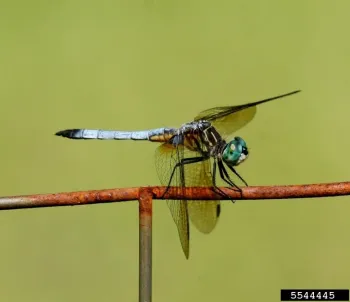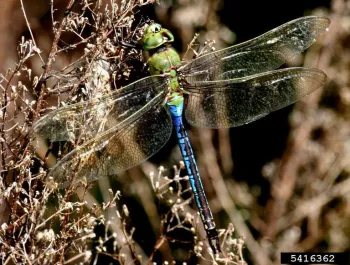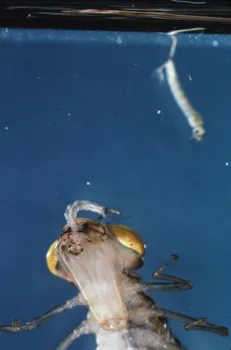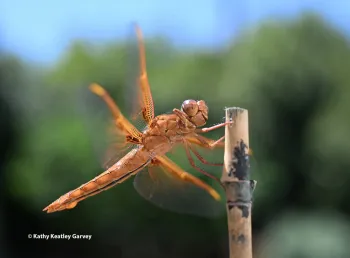
I’m always delighted to see the first dragonflies of the summer zipping through my garden. Dragonflies are such magical creatures with their dazzling aerobatics, vibrant colors, and wings shimmering in the sunlight.
These fascinating insects are easily recognized by their long, slender bodies and distinctive narrow four wings. Dragonflies are ancient insects whose ancestors existed before dinosaurs! Members of the suborder Anisoptera (meaning ‘unequal wings’) the adult dragonfly’s hindwings are typically larger and broader than their smaller, narrower forewings
Dragonflies and damselflies are similar species which are sometimes confused for each other, but there are easily observable differences. Dragonflies are generally larger and thicker with wings spread at rest and are more agile flyers capable of hovering and flying backwards with wings usually beating together. Damselflies are smaller, more delicate, hold their wings together at rest, and are slower, weaker fliers, usually fluttering or floating in the air with wings typically beating at different times.
Distribution, Diet, Life Cycle

There are at least 3,000 species of dragonflies in the world. Their habitats are generally near freshwater lakes, streams, marshes, and temporary vernal pools. Their distribution is strongly influenced by the availability of clean water and suitable breeding grounds. Urban areas where water quality can be compromised tend to see fewer species.
Their diet depends on their stage of life. Both larvae and adults are voracious feeders. Eggs are laid in or near water where the hatched aquatic nymphs (larvae) live, feeding on aquatic insects, particularly mosquito larvae, as well as small crustaceans and fish, and tadpoles. Once the nymphs molt into adults they consume a wide variety of flying insects including mosquitoes, flies, butterflies, moths, bees, and even other dragonflies. With their superb eyesight and agile flying abilities, they often catch their prey in mid-air.
Dragonflies spend most of their lives as aquatic nymphs, a stage that can last for several years. Depending on the species, adults can live from a few weeks up to about six months.
Dragonflies are seasonal, with most species emerging during the warmer months during which they mate (often in mid-air) and hunt. Their life cycle is closely related to temperature and water availability, so seasonal variations can impact population levels. A wet winter might lead to an abundance of nymphs, resulting in a summer surge. Conversely, drought conditions can reduce breeding success.
Dragonflies in California

California has about 100 species of dragonflies. The Sierra Nevada foothills with their often-pristine mountain streams and the Central Valley’s vibrant wetlands are particularly rich in dragonfly diversity. However, dragonflies can be found in urban and suburban areas, darting around parks, gardens and small backyard ponds where water may be found. Here are four commonly seen species:
- Blue Dashers (Pachydiplax longipennis): One of the most common dragonflies in California, at 1-1.5 inches long, males are vibrant blue with yellow-striped thoraces and metallic green eyes. Females have brown and yellow abdomens and red eyes. Their bulging, round eyes have 30,000 facets, each seeing in a different direction. Adults feed primarily on mosquitoes, moths, flies and mayflies. Between their incredible eyesight and fast reflexes, the adults catch up to 95% of their prey, making them one of the planet’s most efficient predators.
- Common Green Darner (Anax junius): Adults grow up to 3 inches long making them one of the largest dragonfly species. Both sexes have green thoraces, bull’s eye marks on their faces, and clear wings that become amber-tinted with age. Males also have bluish-purple abdomens with a black stripe down the middle. Unlike many dragonflies, they migrate in winter, traveling as far south as Panama.
- Flame Skimmer (Libellula saturata): Males are 2-2.4 inches long and are entirely red or dark orange, including their eyes, legs and wing veins, making them easy to identify. Females are smaller with medium or dark brown colors with some thin yellow markings. These dragonflies are often attracted to warmer water. They generally hunt from perches on twigs or rocks. Their larvae are highly successful hunters who lurk in the mud of water, waiting to grab prey that pass by, eating freshwater shrimp, small fish, and tadpoles.
- Blue-eyed Darner (Rhionaeschna multicolor): Another relatively large dragonfly at 2.5-3 inches, both male and females are known for their bright blue eyes. Males are dark brown to brownish black with blue markings while females are brown with green markings. They have 360-degree vision, can fly forward and backward, reaching speeds up to 50 miles per hour. Unlike many other dragonfly species, adults often range far from aquatic habitats when not breeding, and can be spotted in city parks, parking lots and other urban areas. They can be migratory, with large numbers showing up in the fall months.
Importance and Threats

The presence of dragonflies often indicates a healthy freshwater habitat. They are an important natural pest control, with both adults and nymphs reducing the population of mosquitoes and other troublesome insects. While not known for being pollinators like bees and butterflies, dragonflies do play a role since they pick up and transfer pollen while foraging for insects on flowering plants, particularly in wetland areas.
Significant threats to dragonflies include climate change, habitat loss, chemical contamination of the environment (particularly due to pesticide runoff in water habitats), and invasive species.
We can help create dragonfly-friendly habitats in our backyards by including water features such as a pond. Reducing the use of pesticides and chemical fertilizers will help maintain clean water sources, which is crucial for dragonfly larvae. By helping this valuable, beneficial insect, my hope is that dazzling dragonflies will continue to bring us joy by gracing our gardens.
Resources:
https://uncovercalifornia.com/sports-and-recreation/california-dragonflies
https://birdwatchinghq.com/dragonflies-in-california/
Author: Denise Godbout-Avant has been a UC Master Gardener since 2020.
